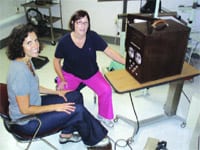For that Fork in the Road Driving Advisement Program Helps Seniors and Others Face a Tough Decision
No one wants to be told they can’t drive. But if a person’s ability to do so becomes questionable due to an illness, injury, or simply old age, it can help to have an independent evaluation that objectively addresses the skills needed behind the wheel — and whether an individual possesses them.
“It’s very sad when you have to tell someone they can’t drive, because it takes away their independence,” says Sheryl Moriarty, an occupational therapist and certified driving rehabilitation specialist for Mercy Medical Center’s Driving Advisement Program. “There are times when we are the last resort for a person who has not been able to accept that their doctor and family says they should not drive.”
The comprehensive program at Weldon Rehabilitation Hospital measures vision, cognitive skills, strength, flexibility, and endurance, and usually includes a session on the road with a licensed driving instructor. The assessment takes about 90 minutes and costs $350 to $375 without insurance.
“We have seen people ages 15 to 94, because there many conditions that can affect a person’s ability to drive safely,” Moriarty said. They include accidents, illnesses, injuries, strokes, heart attacks, medications, dementia, and developmental delays or physical disabilities.
“We see adolescents with autism or learning disorders. Some are referred to us from Shriner’s Hospital for Children, because they have a limb-length deficiency or cerebral palsy,” Moriarty said. “There are also seniors and people with cognitive or physical problems. Some are taking cardiac medications that can significantly affect their ability to drive. Everyone has a different story.”
For this issue, The Healthcare News looks at some of those stories, and how the driving program steers its clients in the right direction.
First Gear
The clinical evaluation begins with an interview. “We get their medical history, their driving history, and their goals,” said Moriarty. “It’s important to know if the person has to drive a tractor-trailer truck for work, or if they rarely leave their town.”
The next step is a physical evaluation. “We measure how well the person’s arms and legs move, as well as their reaction time, their range of motion, and their strength and coordination,” Moriarty said.
Some of the testing is done using a machine called a Porto Clinic. The person sits in a chair with a platform in front of them that contains a simulated brake and gas pedal. When they are instructed to begin driving, they must pay attention to a panel of lights in a box in front of them.
“When they see the red light go on, they have to switch from the gas pedal to the brake pedal,” she explained. “It contains a timer and shows us how quickly they react. Their reaction time is important because a driver may have someone slam on their brakes in front of them. We also assess their divided-reaction time, which is done using both sounds and lights. When people are driving, they need to be aware of sirens and horns, in addition to taking things in visually.”
Moriarty recently tested a woman who asked her to shut the door in the room, because she couldn’t concentrate with people walking by in the hallway. This gave Moriarty insight into the woman’s ability to handle unexpected situations. “I told her that we couldn’t shut the door, because when she is on the road, there will be many distractions.”
Vision and depth perception are also tested, and people are sometimes referred to an ophthalmologist.
Cognitive ability is another area that is measured. People are shown a picture of traffic signs and asked to explain what they mean. They are also questioned about stopping for school buses and who has the right of way in different situations.
“We have seen people who can’t tell us what a stop sign means. Others have trouble with more complex signs, such as those that warn them not to take a left,” said Moriarty, adding that a large number of accidents caused by older drivers involve left turns into oncoming traffic.
Problem solving is also addressed. “We ask people what they would do if they get a flat tire. Many seniors tell us they have cell phones, but we discover they don’t know how to use them. So we give them that as an assignment,” she explained. “It is part of our job to provide education. The result of the evaluation isn’t as simple as saying ‘yes’ or ‘no’ to driving. If a person is driving a tractor-trailer truck, they need to have a different set of skills than a person who is only going to drive back and forth to the senior center.”
The person’s memory is also evaluated through a series of questions, which range from what the day and date is to the route they take to get to a desired destination.
“There is a lot that goes into an assessment,” Moriarty told The Healthcare News. “If someone has a cognitive or memory deficit, they won’t have the visual clues they need to drive after dark. For example, if they say they always take a left at ‘the brick house,’ they won’t be able to see it when it is dark and raining.”
Jill LeGates, director of Rehabilitation Services at Weldon, said the occupational therapists who conduct the testing look at the overall functioning of a person. “They are taking stock of the comprehensive picture.”
After finishing the evaluation at Weldon, people are scheduled for a road test with a licensed driving instructor. “They are taken to places such as grocery stores or malls, which can be chaotic or distracting, because drivers have to watch out for other cars and people. They are also taken to streets which have ‘yield’ signs as well as onto the highway, if they will be driving there,” Moriarty said, adding that some people never venture far from home.
“We educate them about blind spots and how they can drive more safely,” she added. “The driving instructor also makes sure they are aware of their environment. If they see a trash truck or someone riding on a bicyle, they need to be able to make an adjustment. We love it when there are detours, because it’s something unexpected.”
Putting On the Brakes
In some cases, it becomes evident before the driving test that the person should not be behind the wheel. But this usually doesn’t come as a surprise, because the individual receives constant feedback during the evaluation.
“I point out when things don’t go well. It’s important that they understand the factors that make it unsafe for them to drive,” Moriarty said. “Sometimes I can tell them what they need to work on. But some people have been diagnosed with progressive conditions such as Alzheimer’s, and we know they are not going to get better.”
In cases where a person has had a brain injury or stroke, the occupational therapist may be the first person to tell them they have a deficit. “You can’t hide a slow reaction time,” she said. “We explain that, if a child pulls out in front of them on a bicycle and their reaction time is five times slower than normal, they are putting themselves and the child in harm’s way by driving.”
The final results of the test lead to several options. Some people can be helped by using adaptive equipment, others are told they will need to be reassessed after they have had more time to heal from an accident or injury, and people with poor cognitive skills may be advised to limit their driving to places they know.
In other instances, it’s necessary to deliver the dreaded news that it is no longer safe for the person to be behind the wheel. When that happens, alternative transportation is discussed before the individual leaves Weldon.
LeGates explained that, although Moriarty and other occupational therapists make recommendations, the Registry of Motor Vehicles is the only agency in Massachusetts authorized to restrict or take away a person’s license.
“This is an advisement program on how to be a safe driver for as long as possible,” LeGates said. “We are not a legal enforcement agency.”
But people do take the results of the evaluation seriously, she added. And the news is delivered in a manner that is informative, gentle, and factual. “We do everything we can to be objective,” she said.
And make the roads a safer place, one assessment at a time.




Comments are closed.